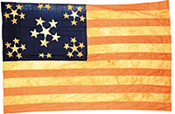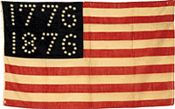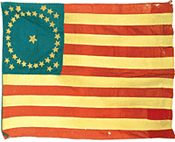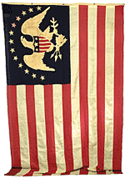|
Cowan's
Corner
Collecting Old Glory
By Wes Cowan
As we approach July 4th, I'm reminded of a collecting area that has grown
increasingly popular in the last few years: American flags and other patriotic
textiles. While corporate heads, lawyers and other executives have traditionally
dominated the market for patriotic Americana, more and more, flags are being
used to decorate family rooms in the average American home. The result? Prices
of vintage quality flags have skyrocketed.
Part of this interest is due to
the wave of patriotic sentiment that has swept the country since 9/11. But flags
are one of those collecting fields where interest seems to have finally awakened
to the beauty and rarity of a previously ignored class of antique.
Few of us
realize that the flag of today has undergone significant evolution over the
course of the history of our republic. Flag Day-June 14th-commemorates the first
official flag act of the Continental Congress passed on that day in 1777. This
act dictated that the flag be composed of 13 alternating red and white stripes,
with the union being composed of 13 white stars in a field of blue. In 1818,
Congress mandated that a star be added for each new state, to be added on the
4th of July following their admission to the union. It wasn't until June 24,
1912 that President William Howard Taft signed an executive order establishing
proportions for the flag and provided for the arrangement of stars in rows.
Before the Civil War, there were few professional flag makers in America,
with most being made by amateur seamstresses. Because of this lack of official
oversight, early antique flags exhibit a dizzying array of combinations of
stripes and stars. Collectors revel in this unruliness. "Home made" examples
with unusual star or stripe configurations command premium prices.
Flags
flown during periods of national conflict are also highly sought after.
Collectors look for flags where the union, or canton, rests on a red stripe, as
opposed to the more typical pattern of white. This stripe arrangement begins to
appear during the Mexican War and regularly occurs during the Civil War.
Consequently, collectors often refer to this red bar as a "blood stripe"
indicating a Nation at war. Military or other flags that incorporate another
powerful symbol of our nation, the American eagle, as well as battle flags from
any great conflict are highly sought after.
In general, flags with 37 stars
or less are more desirable than those with higher numbers, and overall size also
affects value. Flags that can be easily framed and displayed typically sell for
more than the huge examples that fly over our public buildings.
While the
prices for rare flags puts them out of the reach of most collectors, many fine
flags can still be purchased for a few hundred dollars. Whether framed and hung
in the family room, or flown or hung outdoors on special holidays, antique
American flags are a hot commodity.
 Wes Cowan is founder and owner of Cowan's Auctions, Inc. in Cincinnati, Ohio and
Danica Farnand heads Cowan's American Indian division. An internationally
recognized expert in historic Americana, Wes stars in the PBS television series
"History Detectives" and is a featured appraiser on "Antiques Roadshow". He can
be reached at info@historicamericana.com. Wes Cowan is founder and owner of Cowan's Auctions, Inc. in Cincinnati, Ohio and
Danica Farnand heads Cowan's American Indian division. An internationally
recognized expert in historic Americana, Wes stars in the PBS television series
"History Detectives" and is a featured appraiser on "Antiques Roadshow". He can
be reached at info@historicamericana.com.
|

Unusual star arrangements like on this 34-star flag are much sought after by
collectors.

This flag commemorates the 1876 Centennial of the United States. (All photos,
courtesy of Cowan's Auctions, Inc.)

36-star American flag produced during the Civil War, sold for $5,500 in
2004.

Rare ca. 1850s flag featuring an American eagle, sold for $37,500 at a 2004
Cowan's auction.
|